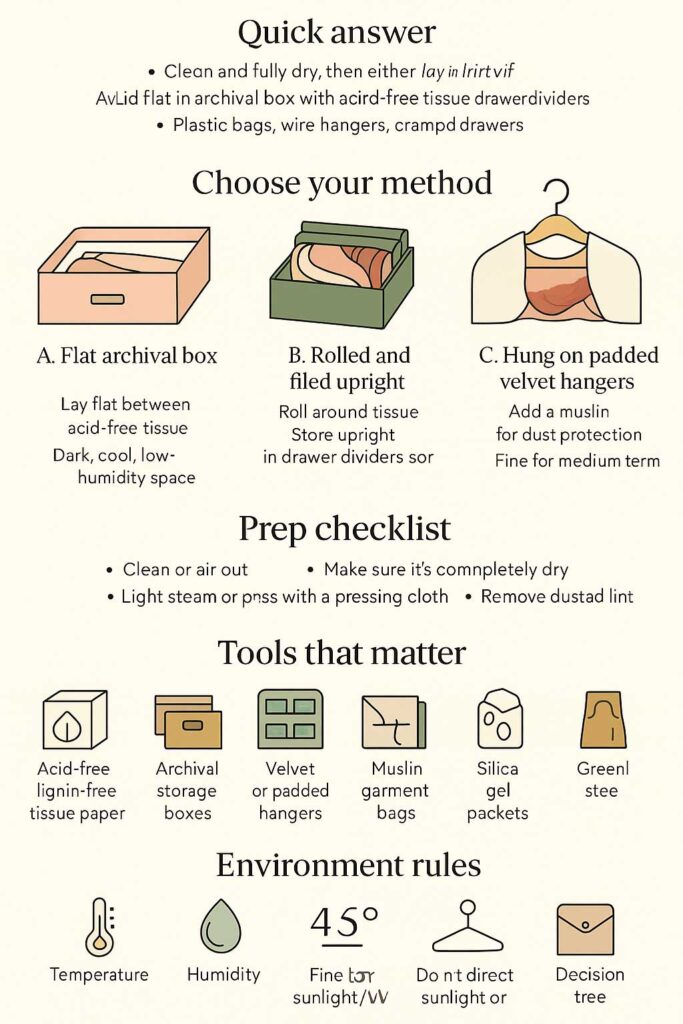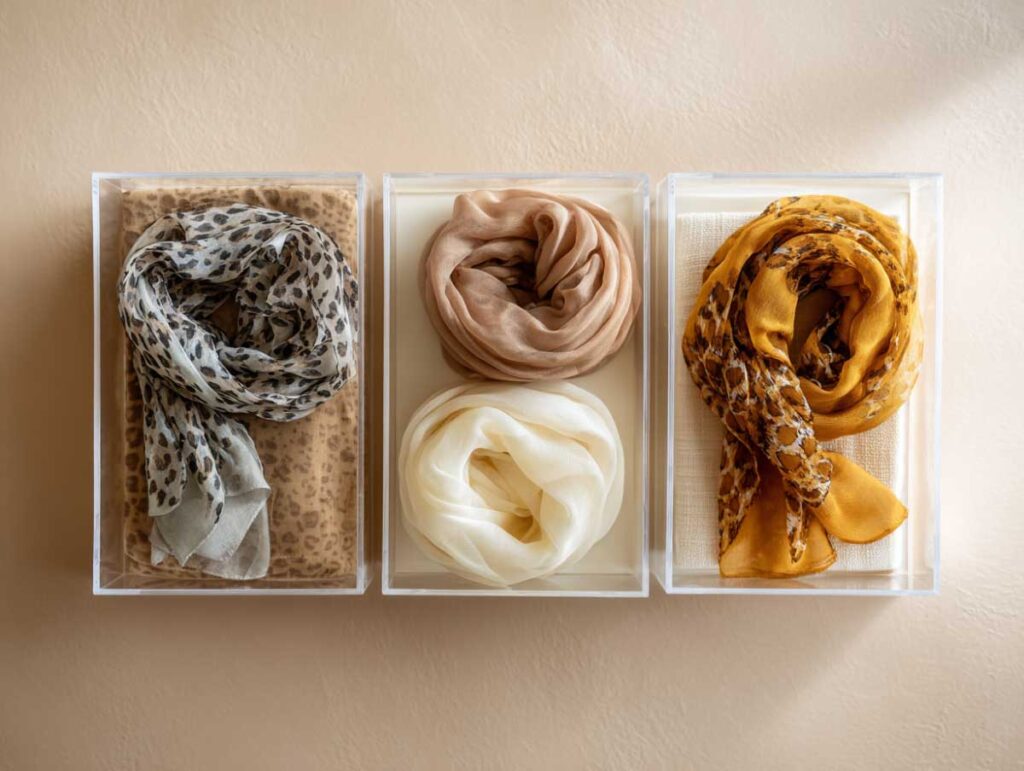To store silk scarves so they don’t wrinkle, clean and fully dry them first, then either lay them flat in an archival box separated with acid free tissue paper or roll them loosely around tissue and file them upright in a divided drawer. Avoid plastic bags that trap moisture, wire hangers that dent the fabric, and overstuffed drawers that press in hard creases. Those two methods, flat archival and gently rolled, have kept my scarves smooth for years.
I am sharing exactly how I prep, fold, roll, hang, and even travel with my silk pieces, plus the tools that actually matter: acid free tissue paper, breathable boxes, padded or velvet hangers, and good humidity control. I will naturally work in related keywords like store silk scarves without wrinkles, rolling silk scarves, acid free tissue paper for silk, and how to hang silk scarves so the post is easy to find and even easier to use.
The three safest storage methods
- Flat in an archival box with acid free tissue: best for collectors and long term storage.
- Rolled loosely and filed upright in drawer dividers or acrylic bins: best for everyday rotation and small spaces.
- Hung on padded or velvet hangers, protected with a muslin sleeve: fine for medium term if you prefer to see everything at a glance.
Why silk wrinkles and creases
Silk is a protein fiber. It holds beautiful drape, but it also remembers pressure, moisture, and heat. Long, tight folds set hard creases, especially if the scarf is stored under weight or in a humid room. That is why a prevent wrinkles silk scarf plan always starts with low pressure, breathable storage, and gentle support.
Pre storage checklist
Do these four things before you put any scarf away:
- Clean or at least air out: perfume, body oils, and sweat will set over time.
- Make sure it is completely dry: moisture invites mildew and waves.
- De wrinkle first: lightly steam or press on the silk setting with a pressing cloth.
- Remove dust and lint: micro debris can abrade fibers during long storage.
Method A: flat and layered in an archival box

Best for: vintage and designer scarves, Hermès pieces, anything you wear rarely but want to keep pristine.
How I do it:
- Place the scarf flat on a sheet of acid free, lignin free tissue paper.
- Smooth it with clean, dry hands.
- Lay another sheet of tissue on top.
- Stack a few scarves, but never overfill the box.
- Store the archival storage box in a dark, cool, low humidity space, far from sunlight or radiators.
Method B: rolled and filed upright in a drawer
Best for: everyday wearers who want quick access without creases.
How I do it:
- Lay the scarf on acid free tissue and smooth it.
- Place a little tissue roll at one edge.
- Roll both together gently and loosely.
- Tie with a soft cotton ribbon if needed, never tight elastic.
- Stand the rolls upright in drawer dividers or acrylic bins, book-style, so nothing compresses them.
Method C: hanging on padded or velvet hangers
Best for: you want to see everything fast and you are okay with a little maintenance steaming.
How I do it:
- Use padded, wide, velvet, or flocked hangers that prevent slipping and dents.
- Slip a muslin sleeve or cotton pillowcase over the hanger if you want extra dust protection.
- Multi tier scarf hangers can work, but choose ones with wide bars and no sharp clips.
Step by step: folding, rolling, and flat layering
Flat layering
- Place scarf flat on tissue.
- Smooth, cover with a second tissue sheet.
- Stack lightly in an archival box.
- Label boxes so you do not repeatedly refold the same pieces while hunting.
Rolling
- Place scarf on tissue.
- Roll loosely with a tissue core.
- File upright in a divided drawer or bin.
Folding (only if you must)
- Fold as few times as possible, avoid sharp corners, and slide acid free tissue between every fold to soften creases.
Tools and materials worth buying
- Acid free, lignin free tissue paper
- Archival storage boxes or your original brand boxes relined with fresh tissue
- Velvet or padded hangers and multi bar scarf hangers with wide bars
- Drawer dividers or clear acrylic bins for the rolling method
- Silica gel packets to keep humidity in check
- Muslin or cotton breathable garment bags, never PVC
- A gentle handheld steamer for de wrinkling
Control the environment: temperature, humidity, light
- Temperature: cool and stable. Skip attics and basements.
- Humidity: aim for roughly 45 to 55 percent. Use silica gel or a dehumidifier in damp climates.
- Light: avoid direct sunlight. UV fades silk and weakens fibers over time.
Travel: pack silk scarves without wrinkles
- Roll loosely around tissue and slide into a hard sided sunglass case or slim accessory tube.
- Use a folder packing envelope inside your carry on for flat storage.
- At your destination, hang the scarf in the bathroom while you shower to relax light creases.
- For stubborn wrinkles, a mini steamer or even a hair dryer on cool with a pressing cloth works in a pinch.
How to fix creases safely
- Garment steamer on low, hold a few inches away.
- Iron on silk setting with a pressing cloth, never direct contact on the print.
- Steam from the wrong side if you are worried about shine.
- Avoid spraying water directly on delicate prints to prevent watermarking.
Mistakes to avoid
- Plastic dry cleaner bags or PVC covers: they trap moisture and can off-gas.
- Wire hangers and metal clips: they dent, snag, and can rust.
- Vacuum seal bags: they crush silk and set hard creases.
- Stacking heavy sweaters on top of your scarf boxes.
- Folding along the same lines every time: that is how permanent creases form.
Quick decision tree
- Collector piece, long term: flat, archival box, acid free tissue.
- Daily wear, small space: roll and file upright in drawer dividers.
- Need visibility, limited drawers: hang on padded or velvet hangers with a breathable cover.
- Traveling soon: roll with tissue, protect inside a hard case.
Shopping checklist
- Acid free, lignin free tissue paper
- Archival or brand scarf boxes
- Velvet or padded hangers with wide bars
- Drawer dividers or acrylic bins
- Muslin garment bags
- Silica gel packets
- Gentle handheld steamer and a pressing cloth
FAQs
Is it better to roll or fold silk scarves to prevent wrinkles?
Rolling is usually better for everyday access. For long term, flat with tissue in an archival box wins.
Can I store silk scarves in plastic bags?
I would not. Plastic traps moisture and can cause yellowing or mildew. Use breathable cotton or archival boxes instead.
How do I get creases out of a silk scarf safely?
Light steaming is the safest. If you iron, use the lowest silk setting, a pressing cloth, and no direct contact with the print.
What kind of tissue paper should I use for silk?
Acid free and lignin free. Regular tissue can discolor silk over time.
Can I hang silk scarves without stretching them?
Yes, on padded or velvet hangers that distribute weight. Avoid thin metal hangers and clips.
Do silica gel packets help protect silk?
Yes, they keep humidity in a safer range. Replace them periodically.
My final take
For my collection, I split storage by how often I wear each piece. Rarely worn and sentimental scarves live flat in archival boxes with acid free tissue. Daily scarves are rolled and filed upright in a drawer with dividers. I steam lightly before I wear them, never use plastic bags, and I skip wire hangers completely. Follow that system and you will keep your silk smooth, vivid, and crease free for years.





